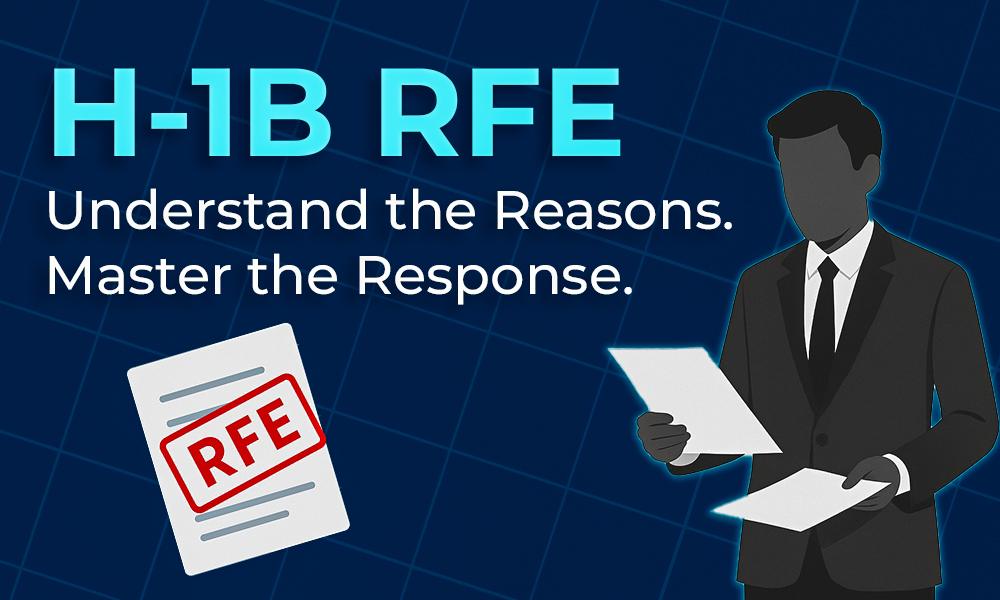H-1B visa is one of the most popular U.S. work visas, allowing employers to hire foreign
professionals in specialty occupations such as IT, engineering, finance, architecture, and
healthcare. However, due to increased scrutiny from U.S. Citizenship and Immigration Services
(USCIS), many petitions face a Request for Evidence (RFE).
Receiving an RFE can feel discouraging, but it’s important to remember: an RFE is not a
denial. Instead, it is USCIS’s way of asking for additional information before making a final
decision. A strong, well-prepared response can turn an RFE into an approval.
This guide explains:
● What an RFE is.
● The most common reasons for H-1B RFEs.
● Effective strategies for preparing a successful response.
What is a Request for Evidence (RFE)?
An RFE is an official notice from USCIS stating that the initial petition lacked sufficient
evidence or had unclear information.
An RFE will:
● Identify the issues USCIS needs clarified.
● List the type of evidence or documents that can resolve those issues.
● Set a firm deadline for submission (commonly 60–90 days).
If the deadline is missed or the response is incomplete, USCIS will likely deny the petition.
Why USCIS Issues RFEs for H-1B Petitions?
While RFEs can be issued for a variety of reasons, certain issues tend to arise more frequently.
The most common include:
1. Specialty Occupation Doubts
The H-1B is only for specialty occupations — jobs that require specialized knowledge and a
minimum of a bachelor’s degree in a specific field. USCIS may question:
● Whether the position truly requires a specialized degree.
● If the duties are described in vague or generic terms.
● Whether the degree field aligns with the role.
Example:
A petition for a “Business Analyst” that lists duties like “prepare reports” without showing
advanced analytical or technical requirements might trigger an RFE.
2. Employer–Employee Relationship
USCIS must see that the employer will have control over the H-1B worker’s duties, hours, work
location, and performance. This is especially important in third-party placement cases.
Evidence often requested:
● Signed contracts and subcontracts.
● Statements of work (SOWs).
● Organizational charts.
● Records of supervision or performance reviews.
3. Availability of Work
When a worker will be placed at client sites or on short-term projects, USCIS may ask for proof
that there will be enough qualifying work for the entire requested visa period.
Evidence often requested:
● Client letters confirming project scope and duration.
● Detailed project descriptions.
● Work itineraries that meet USCIS regulations.
4. Beneficiary’s Qualifications
The beneficiary must have the required education and experience. An RFE may be issued if:
● The degree is in a different but related field.
● The degree is foreign and not yet evaluated for U.S. equivalency.
● Work experience is being used instead of a degree without proper documentation.
Example:
A candidate with a Mechanical Engineering degree is offered a Software Engineer role. USCIS
may issue an RFE because the degree field does not clearly match the job.
To respond, the petitioner could:
● Provide a credentials evaluation equating the candidate’s combined coursework and
professional experience to a U.S. Computer Science degree.
● Submit letters from past employers describing programming experience.
5. Labor Condition Application (LCA) Issues
The LCA, certified by the Department of Labor, must match the petition exactly. RFEs can be
triggered if:
● The job title or job code is different.
● The work location does not match the LCA.
● The wage level is inconsistent.
Example:
If the LCA lists Dallas, Texas, as the worksite but the petition says Austin, Texas, USCIS will
issue an RFE for the discrepancy. The employer can correct this by filing an amended LCA and
providing proof of the updated posting notice.
6. Maintenance of Status
If the worker is already in the U.S., USCIS may request proof that they have maintained valid
immigration status until the filing date.
Evidence examples:
● Recent pay stubs.
● I-94 travel records.
● Approval notices from prior visas.
Case Example:
An F-1 OPT student switching to H-1B has a two-month gap in pay stubs. USCIS may suspect
the student fell out of status.
7. Ability to Pay
While more common in employment-based green card cases, USCIS can ask for ability to pay
evidence in H-1B cases — especially when:
● The employer is small or newly established.
● The offered salary is high compared to reported payroll.
● USCIS questions the company’s financial stability.
Example:
A startup with $25,000 in annual revenue offers an H-1B salary of $90,000. USCIS may question
how the salary will be paid.
Evidence often requested:
● Tax returns or audited financial statements.
● Bank statements showing sufficient reserves.
● Payroll records showing ongoing wage payments.
Effective Strategies for Responding to an H-1B RFE
Responding to an RFE is about clarity, completeness, and credibility. Here’s how to approach
it:
1. Read and Analyze the RFE Carefully
● Break down the RFE into specific points or questions.
● Make a checklist to ensure you address every issue raised.
2. Provide Detailed and Specific Evidence
● Avoid generic job descriptions.
● Link duties directly to specialized academic knowledge.
● Include supporting documents like expert opinion letters, industry job postings, and
academic transcripts.
3. Reinforce the Specialty Occupation Requirement
● Show that the role meets at least one of the criteria in the H-1B regulations.
● Provide proof that similar jobs in the industry require a bachelor’s degree.
● Map the duties to relevant courses from the beneficiary’s degree program.
4. Demonstrate Employer Control
If the worker will be at a client site:
● Include contracts stating the employer directs the work.
● Show evidence of ongoing supervision and evaluation.
5. Ensure Consistency Across All Documents
● Check that job title, duties, location, and wage are the same on the petition, LCA,
contracts, and all supporting evidence.
● Correct any inconsistencies before submission.
6. Organize Your Response Professionally
● Use a cover letter summarizing USCIS concerns and the evidence provided.
● Label exhibits clearly and logically (e.g., “Exhibit A – Certified LCA”).
● Keep the format clean and easy to follow.
7. Consider Professional Assistance
An experienced Immigration Attorney or Accredited Representative can:
● Spot weaknesses in the original petition.
● Draft persuasive legal arguments.
● Ensure all evidence meets USCIS requirements.
Frequently Asked Questions
1) Can I get more time to respond to an RFE?
Generally, no. USCIS’s COVID-19 flexibility that allowed extra time ended for notices dated
after Mar 23, 2023. You must respond by the deadline printed on the RFE unless the notice itself
provides otherwise.
2) Can I upgrade my H-1B case to Premium Processing after receiving an RFE?
Yes, you can. You can file Form I-907, Request for Premium Processing Service, along with your
RFE response. If you do this, the 15-day premium processing clock will begin on the date USCIS
receives both the Form I-907 and your complete RFE response. This is a common strategy for
petitioners who want a faster decision after the RFE delay.
3) Can I travel or change employers while an H-1B RFE is pending?
Travel: If your petition includes a change of status request, departing the U.S. before
adjudication is considered abandonment of that change-of-status request (the underlying petition
can still be approved for consular processing).
Change employers (portability): Eligible H-1B workers may begin with a new employer once
the new, nonfrivolous H-1B petition is properly filed and they’ve maintained status (AC21
portability). Timing and eligibility must be verified case-by-case.
4) Do I need a new LCA or amendment for remote/hybrid or new client sites?
● Short, temporary placements at a location not on the LCA may be allowed under
short-term placement rules (typically up to 30 workdays, sometimes up to 60) if all
regulatory conditions are met.
● A move to a new MSA (area of intended employment) is generally a material change
requiring an amended H-1B petition before work begins at the new site. Posting alone is
not enough.
Final Thoughts
An H-1B RFE may slow the process, but it does not have to stop it. With careful preparation,
strong evidence, and clear explanations, many RFEs lead to approvals.
By understanding the most common triggers- from specialty occupation doubts to
employer–employee relationship concerns, LCA inconsistencies, and ability to pay questions —
you can anticipate issues and address them proactively.
The key is to respond with accuracy, completeness, and professionalism so USCIS has
everything it needs to approve your petition.

